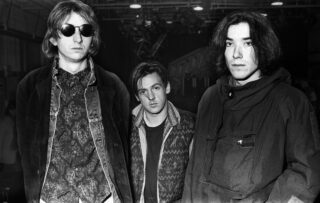Primer playlist: a beginner’s guide to Talk Talk in playlist form
Our members-only introduction to the incredible back catalogue of London art-rock group Talk Talk, and their visionary songwriter Mark Hollis

Our members-only introduction to the incredible back catalogue of London art-rock group Talk Talk, and their visionary songwriter Mark Hollis
For many, the way Talk Talk are discussed tends to occupy the uncomfortable space between the pretentious and the reverent. Their reputation typically rests on their final two studio albums, Spirit of Eden and Laughing Stock – the band’s richest but most challenging works. However, there is much more to Talk Talk, and most of it is gilded with accessible pop brilliance.
Formed in Tottenham, North London in 1981, Talk Talk entered a scene dominated by New Romantics; unsurprisingly, as a group of four relatively good-looking young lads, their label EMI quickly packaged them as the new Duran Duran.
On the surface it appears a fair comparison. They had a similarly repetitive band name, opened for Duran Duran before the release of their debut album The Party’s Over, and even chose the same producer for that record. However, you could not find two bands more different at their core.
Talk Talk’s taciturn talisman and vocalist Mark Hollis appeared uninterested in playing the pop pin-up game from the start, generally harbouring an air of indifference, occasionally being uncooperative in interviews and citing recondite influences such as French avant-garde composers Claude Debussy and Erik Satie, the maverick Beat-writer William S. Burroughs and Miles Davis’ experimental period. Spandau Ballet they were not.
In their struggle for sonic emancipation, Talk Talk’s early, more pop-dominated songs carry a unique tension, marrying the opposed pressures of commercial and artistic fulfilment. Many millennials’ first unconscious exposure would have been the anthemic and liberating ‘Life’s What You Make It’ found on Grand Theft Auto: Vice City’s Flash FM radio station, where it was the perfect soundtrack for five-star-rated police chases. ‘It’s My Life’ enjoys a similar existence, propelled by an infectiously catchy chorus that everyone instinctively knows the words to.
Third album The Colour of Spring is the point at which the balance begins to tilt, from mainstream to experimental. The new-wave synths and raucous energy were toned down and replaced with rich organic instrumentation and a more ruminative pace. The result was a critical and commercial hit.
Songs such as ‘Living in Another World’, ‘Give It Up’ and ‘Time It’s Time’ are perfect encapsulations of the dynamic mix the band had achieved between pop aesthetics and avant-garde aspirations. The success gave Talk Talk carte blanche from EMI for their next album. They finally had the resources to do what they had wanted to do all along.
For their fourth album the band, now a trio, eschewed almost every music industry formality, ditching the typical recording process and instead setting up inside a disused North London church hall, into which they invited a revolving door of wide-ranging musicians (including violinist Nigel Kennedy) to play. In this cavernous space, lit only by a flashing strobe light, Hollis would ask the mostly classical musicians to improvise, micing up the room to allow the sounds to bleed through while he sat behind the decks. He would give no instruction or judgement. He would just listen.
Songs were cut out from the reels of improvised recordings like tapestries. The resulting epics, filled with organs, acoustic strings, percussions and other natural instruments, became the six songs of Spirit of Eden. There were no singles in sight.
It’s a magical, free-flowing and timeless album, where mistakes are honoured and Hollis’ sparse blank verse is impossible to pin down, the lyrics slipping through your fingers like water if you tried to grasp them. It was the antithesis of everything Talk Talk had started their career doing.
Spirit of Eden fully embodied the shock of the new, and no-one knew what to do with it – not least EMI, who simply advertised it as “an album for 1988”, whatever that meant. Some deemed the album “almost wilfully obscure” and sales were disappointing, but Talk Talk couldn’t care less. After a litigious exit from EMI, expedited by the unauthorised release of an album full of remixes of their songs, Talk Talk’s final album, Laughing Stock, was released in 1991 on jazz label Verve Records.
It completed the band’s graceful divergence from their beginnings, their sound even looser and more deconstructed, the music boiled to its essence, full of feeling and heart where there had once been slick superficial style. Even now, there’s nothing quite like it.
Reviewing Laughing Stock, Melody Maker declared Talk Talk “are probably the most important group we have.” However, just as they were being acknowledged for their true sound, they were gone. The remaining members of Talk Talk, Hollis and drummer Lee Harris, disbanded soon to rumours of an unbelievably tense recording experience.
A few years passed before Hollis released his sole solo album in 1998, which could be seen as Talk Talk’s final form, evinced of all members except him. It is his quietest, most stirring statement, a final dart of thought before he largely retreated from public life. His untimely death, aged 64, was announced in 2019.
For all the high-brow baggage that people lump on Talk Talk, they are at heart a simple band with a simple goal. Listening through their discography, you’re following them along their sonic pilgrimage, always moving forward towards something new, beginning with superficial sound and ending in sonorous silence. Everything in between, you feel, was just a beautiful compromise.
Spotify
Apple
YouTube